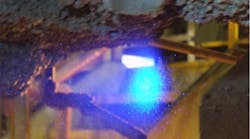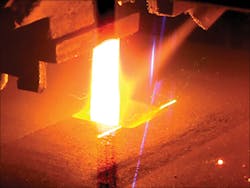In foundries using in-stream inoculation, it is common to see a layer of inoculant on top of the mold after the mold has been poured. This indicates two things: Only part of the inoculation hits the metal stream (and enters into the casting) and a lot of inoculation is wasted (resulting in reduced sand quality and increased cost.) The new inoTECH™ System from pour-tech AB provides the means to see the inoculant cloud in front of the iron stream, making it possible to calculate a hit-rate (how much of the total inoculant is in line with the iron stream.)
Previously available vision systems rely on the iron stream “back-lighting” the inoculant grains in order to see them as black dots in front of the stream. However, this method does not allow detection of the inoculant on either side of the iron stream, making it impossible to get a complete view of the inoculant “cloud”.
inoTECH™ uses a special camera and an active light source (a line laser) to detect the inoculant. The laser acts as a light curtain, illuminating the inoculant as it passes through the iron stream. Then, the camera is able to detect the inoculation grains. By special filtering, the camera also can see the iron stream behind the inoculation cloud and counts how many grains are in line with the stream, and how many are to the left or right side of it.
By dividing the number of grains detected in line with the stream, divided by the total number of grains, a hit rate can be calculated. Based on the hit rate, the inoTECH™ can provide a warning to the operator to adjust the inoculation pipe if the hit rate is low, or stop the molding line if the hit rate is way too low. A “no inoculant detected” alarm is provided if the number of detections in the start of the pour is too low. This alarm can be used to stop the pour, before a bad, un-inoculated casting is produced.
In addition to the operator HMI, the system features a video monitor, providing an image of the pour, which allows the operator to see the inoculant and iron stream in real time. The system takes 4-5 snapshots of the iron stream and inoculant per second, correcting for the movement of the iron stream every time.
As the system calculates the hit rate, it also can determine if the inoculation pipe should be adjusted left or right to achieve a higher hit rate. If the inoculation unit has the ability to move the inoculation pipe (servo motor or similar), the system can provide outputs to adjust the pipe in the right direction.
inoTECH is available both as an integrated part of the pourTECH™ Automatic Pouring system and as a stand-alone unit (where it can be integrated with virtually any bottom pouring system and inoculation unit.)
The hit rate data can be uploaded to a plant data collection system and become part of the quality record for each pour, together with other data such as alarms, cycle times, detection amounts, etc. (several hours of hit rate data is available for viewing directly on the system HMI.
By ensuring that as much as possible of the injected inoculant actually hits the iron stream, the casting process is improved, resulting in higher casting quality and a reduction of inoculant waste.
inoTECH™ reduces the possibility of under-inoculated castings being produced, which gives both the plant metallurgist and the foundry’s customers peace of mind.
Goran Lowback is the president of Viking Technologies Inc. Contact him at [email protected], or visit www.viking-technologies.com










